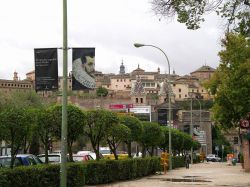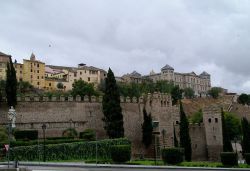Common description
Toledo, declared a national monument of Spain, looks like one big museum. In 1987, Toledo is listed as a UNESCO World Heritage Site. The city is well preserved in its own historical style. The best way to explore Toledo is to stroll through the city and see for yourself the structure of different eras. Since the time of the Romans, the city has preserved the Amphitheater and Aqueduct. When the Goths invaded Spain in the 6th century, they made Toledo the capital of their empire. The reminder of that era is the fortress of San Cervando. Tolaitola, as the Moors called Toledo, was one of the most important northern Spanish cities. Since then, there are two mosques and three city gates. The Mosque of Mesquita del Cristo de la Luz X century is very well preserved. Its architecture (construction with 9 domes) was influenced by the large mosque of Cordoba.
In its medieval past, Toledo is a cradle of Western culture, especially through the Toledo Translators' School, founded by Archbishop Raymond, which itself was an example of tolerance and coexistence of Jewish, Muslim, and Christian cultures.
The cradle of the monarchy, the residence of archbishops, Toledo attracts tourists with the knowledge stored in mosques, synagogues and monasteries. The Cathedral of Toledo, which houses the works of the great El Greco, Goya, Rubens, the Monastery of San Juan de Los Reyes, magnificent bridges, gates, towers, Alcazar Palace, make the streets and squares of the beautiful city of Toledo particularly attractive.
Toledo is known for its generous national cuisine. Many cafes and restaurants allow travelers to try traditional recipes, especially the world-famous marzipan. Especially popular in the world are the souvenirs made in Toledo with black enamel, inlaid with gold, as well as the cold weapons "Blade of Toledo".
In its medieval past, Toledo is a cradle of Western culture, especially through the Toledo Translators' School, founded by Archbishop Raymond, which itself was an example of tolerance and coexistence of Jewish, Muslim, and Christian cultures.
The cradle of the monarchy, the residence of archbishops, Toledo attracts tourists with the knowledge stored in mosques, synagogues and monasteries. The Cathedral of Toledo, which houses the works of the great El Greco, Goya, Rubens, the Monastery of San Juan de Los Reyes, magnificent bridges, gates, towers, Alcazar Palace, make the streets and squares of the beautiful city of Toledo particularly attractive.
Toledo is known for its generous national cuisine. Many cafes and restaurants allow travelers to try traditional recipes, especially the world-famous marzipan. Especially popular in the world are the souvenirs made in Toledo with black enamel, inlaid with gold, as well as the cold weapons "Blade of Toledo".
Toledo on map
+ 20°C




